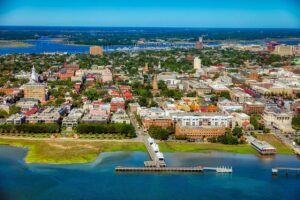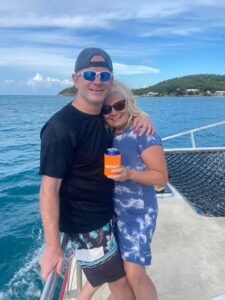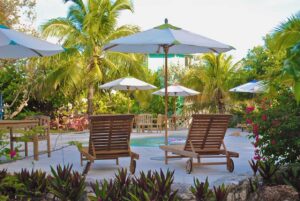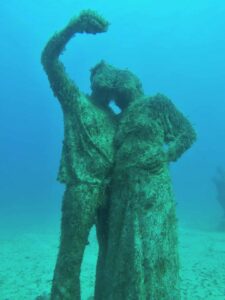Kia Koropp and her husband John Daubeny have been cruising the Pacific, Southeast Asia and Indian Ocean for the past decade with their two young children onboard their 50’ Ganley Solution yacht, Atea. Starting in 2011 from their homeport in Auckland, New Zealand, they have sailed Atea 40,000 miles to their current location in the north Atlantic, having just completed their longest passage of 6,000 miles from Cape Town, South Africa, to the Azores region of Portugal.
Some unexpected new terms entered the global lexicon in 2020. “Lockdown” and “social isolation” have been applied differently in various countries, but they are terms we’ve all come to accept. In the United States, lockdown assumed a political flavor as a portion of the nation asserted an individual’s right to not wear a mask, whereas the rest sought a medical solution to a deepening crisis.

Despite regional variations, lockdown and social isolation are now universally understood terms. Earlier this year, my family and I decided to take it one step further: We applied lockdown and social isolation to a two-month passage from South Africa to Europe.
Spending six continuous weeks at sea was never the plan. Our pre-pandemic schedule included breaking up our journey at the sand dunes of Namibia, the quirky isolation of Saint Helena, the remote secrecy of Ascension and the mystery of the Cape Verde islands. However, these destinations closed their borders one by one as countries around the globe responded to the pandemic.
We predicted Europe would be the first to ease national lockdown regulations, and we calculated a two-month transit would get us there when borders were beginning to open. It was a big risk given our destination was not allowing entry at the time we departed South Africa; only time would tell if we’d made the right decision.
The distance from Cape Town to the Azores is 5,500 miles with an additional 500 miles to account for wind and weather. We would travel from 33° south of the equator to 38° north, a distance akin to sailing nonstop from Vancouver to Auckland. We would cross five distinct weather patterns, each about 1,000 miles in distance. This was farther than we had ever travelled by sea before, but circumstances left us with no other options.
As it happened, the weather patterns we experienced in transit were textbook conditions. We had the southeast winds behind us for our first 1,000 miles and comfortably settled into watch-keeping and schoolwork routines as the coastlines of South Africa, Namibia and Angola passed down our starboard side. We ate, slept and sailed in our own little bubble that had been cast adrift on the winds and waves of the south Atlantic Ocean. We left the crazy world of pandemic-dominated headlines behind and withdrew into a social isolation that most people have never known.
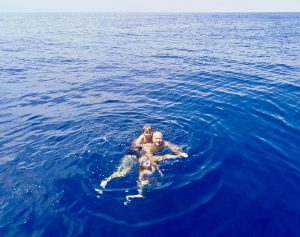
Our next 1,000 miles marked our halfway point around the globe from our initial starting point in New Zealand. At the same time, we celebrated another equatorial crossing as we greeted King Neptune for the fifth time onboard Atea, our 50’ Ganley Solution cutter- rigged sloop. This week provided us with beautiful sailing and a relaxed atmosphere onboard.
The beauty of a long passage is that rather than counting the days to your destination, the time at sea is the destination. With no schedule or outside demands, our daily routine consisted of slow mornings and lazy afternoons, filled with plenty of time to connect as a family. With no marine traffic in sight, our daytime watch-keeping was calm and allowed us to do as we pleased with a lookout set every 15 minutes. John and I would split our evenings into two five-hour watch- keeping blocks, allowing us to enjoy the peace and tranquility of the mid-Atlantic.
With the equator and the halfway point behind us, we eased into the second portion of our journey. The challenge we faced at this point was to find a route into the northern hemisphere weather patterns. At 3,500 miles we hit the Intertropical Convergence Zone (ITCZ), known to sailors as the “doldrums,” or more starkly, the “horse latitudes” (named for the live cargo that used to be thrown overboard due to lack of fresh water while stranded).
With a steady diesel engine, we weren’t worried about being stuck for weeks, but we needed to retain enough fuel for approaching the Azores. We considered two routes: A westerly path would result in stronger wind and less motoring but would add distance to travel and a worse angle on the approach to our destination. An easterly path would offer a shorter distance and better angle, but we would burn up our diesel reserves in light weather, risking being becalmed within sight of land.
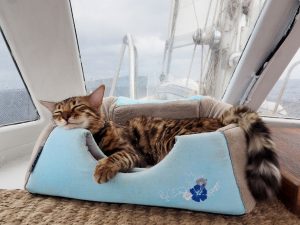
We had no satellite minutes remaining for the month, and our weather map was out of date. Our final path across the finish line would be based on outdated science and a prudent amount of silent prayer.
After motoring our way through the doldrums, we hit the northeast trades during our next 1,000-mile block. This belt of wind is consistent and provided early sailors with a reliable trade route, but our sailing against the wind became a relentless battle.
What followed was a four-day battering that proved to be the toughest stretch of our voyage. With our destination 1,500 miles directly upwind, we spent days pounding into headwinds and punching aside wave after wave in rough seas. Despite being close hauled, Atea was laying 60° off her desired track, and we made more progress sideways rather than toward our destination.
Life onboard was stripped down to the basics: Eat, try to rest, give up on rest and maintain watch. It didn’t take long before our aspirations turned towards golf as a far more desirable pastime.
At 5,000 miles we finally sailed into the Azores High. A meteorologist would refer to this area as the semi-stationary sub-tropical area of high pressure and low winds in the mid-Atlantic. On Atea we referred to the Azores High as “that feeling that you get when the end point becomes tantalizingly close.” It was only at this point that we allowed ourselves to start counting the days remaining.
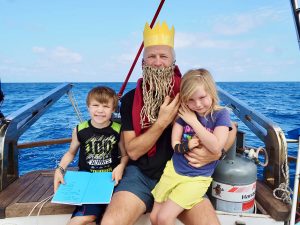
Finally, after 52 days and 5,888 miles our small crew of four completed the ultimate lockdown. The crew did miraculously well, particularly given the two youngest members were under the age of nine. For them, sight of land was a mere nod of the head. Perhaps as adults they will reflect on this trip as an achievement of note, but in their small world their first question was, “When can we go ashore to eat?” Their nonchalant attitude is a reminder that even the most challenging project is nothing without the right attitude.
By breaking the journey down into thousand-mile chunks and celebrating each leg as a milestone along the way, we were able to maintain our focus on the trees we passed rather than the woods ahead of us.
There is a valuable lesson in this experience: We all may be surprised by what we can accomplish by breaking down our biggest challenges into a number of smaller, distinct steps. It is with great pride we look back at two months at sea knowing how satisfying an experience it was and how well we operated through it as a team.
Photos by the Koropp family.


